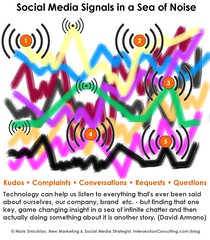Widespread publication on social networks may sometimes yield results, but often causes a lot of noise to accompany the signal.
Here are a couple of real-life examples.
A social media enthusiast is visiting a conference in Sao Paolo. He takes time out, and visits a coffee bar in the city. He tweets where he is, and one of his 4000 twitter followers picks up this tweet and joins him. They have a good conversation.
Another social media enthusiast is at another conference; a social media conference in Los Angeles. He finds he has forgotten his laptop cable. He tweets this to his 1800 followers, and three people at the conference offer him a cable.
These stories illustrate both the power and the weakness of social media. In the first case, the message is relevant to one follower, who happens to be out and about in Sao Paolo that day at that time. It is irrelevant to 3999. He gets a result, from one person. For 3999 people, he creates noise. Signal to noise ratio; 1:3999.
In the second case, the message is relevant to three people, and irrelevant to 1797, for whom it is just noise. Signal to noise ratio 1:899. He would have been far better served to have just made an announcement at the conference itself. Then the message would have been relevant to all its receivers, as they were all at the conference and all had laptop cables. The message would have been all signal, an no noise.
Twitter is a scattergun. The more followers you have, the wider the scatter. Maybe one pellet will hit a target. For the others, its just noise. OK, you can use hashtags to reduce the scatter to a degree, but the signal to noise ratio is often still very low, at least with the hashtags I am familiar with. Filtering is vital if you are to gain value from the stream, given the amount of noise. Compare this to a targeted community forum, where all messages are relevant.
The picture I have reproduced with this post (from Flickr, with attribution) makes the same point. On Flickr, the authors say "There is a need for organizations to develop processes that go beyond the tools, to hear (and act on) relevant signals in the sea of social media noise. The concept of meta-filtering signals and having strategies/resources in place to act on those signals in a meaningful way, adds an important new dimension to social media strategy for business".
There is huge power in connecting people, and social media gives us this power. However attention needs to be paid to the signal:noise ratio. Too much noise and not enough signal, and people start to switch off, even with the best filter. I know I do - there are people I have unfollowed purely due to the excess of noise compared to signal. And sometimes, tools like Twitter are just not the right tools.
Maybe sometimes we need to just speak to the people at the conference, rather than reaching for the iPhone.





No comments:
Post a Comment